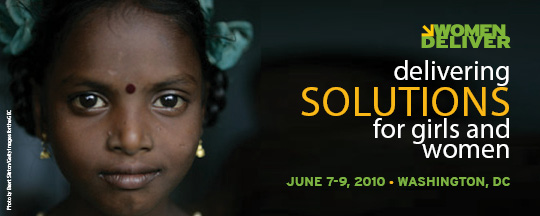2010 Conference

“Women are at the economic heart of the developing world. And to do all this work, they need to be healthy.”
Women Deliver 2010 Focuses on Action
To put world leaders on notice that the time for action on maternal health is now,3,400 advocates, policymakers, development leaders, health care professionals, youth, and media from 146 countries converged on Washington DC on June 7-9 at Women Deliver 2010. More than 800 speeches and presentations were given at the six plenaries and 120 breakout sessions, and the heads of five UN agencies, plus the Secretary-General, were represented. Thirty countries, UN agencies, the World Bank, corporations, and foundations helped support Women Deliver.
The thematic messages from the global conference were positive and resolute:
- Maternal and newborn mortality rates are dropping, but the work is far from done.
- Investing in girls and women is not only the right thing to do, but it makes economic sense.
- Solutions exist to achieve MDG5; what is needed are the political will and allocation of resources.
Media from all over the globe covered Women Deliver 2010. 170 news reporters were on site; 235 in total covered the conference. The media campaign generated 295 news stories. Dr. Richard Horton, the editor of the prestigious medical journal, claimed the Women Deliver meeting as “the most significant event for the future of women and children in 20 years.”
A History of Success: Quick facts about the 2007 Women Deliver conference
Did You Know…
- There were over 2,000 participants from 115 countries.
- Participants included more than 100 government officials from more than 30 countries.
- 40% of the participants were men.
- The conference program included over 300 speakers inspiring dialogue and debate in 118 separate sessions over 3 days.
- The Ministers’ Forum brought together cabinet ministers, parliamentarians and civil society leaders from over 30 countries to shine a high-level policy spotlight on maternal and newborn health.
- The conference held 6 special plenary sessions during which no other sessions ran.
- There were 12 skills-building, strategy, and networking sessions on the last day that enabled participants to develop plans for future action.
- 17 launches of new campaigns, data, and publications in the Speakers’ Corner.
- 75 simultaneous sessions focused on the five conference themes of Women’s and Newborn Health, Promoting Women in the World, Expanding Financial Resources, Advancing Human Rights, and Building Political Will.
- All panels on youth issues featured young speakers.